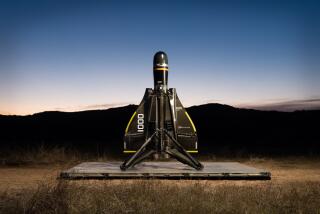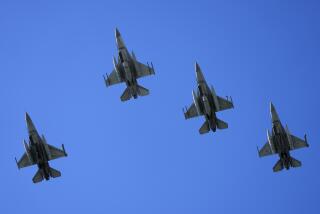Pentagon Gives Rockwell Green Light on X-31 : Keen Maneuverability of Jet Fighter to Make Close Air Combat Viable
- Share via
Rockwell International has received Pentagon approval to complete the final design of an experimental jet fighter, designated the X-31, that is intended to radically improve flight maneuverability in close air combat.
Ultimately, the X-31 may open to question the central design philosophy that the military services have embraced for jet fighters during the past decade, a high-cost philosophy that favors powerful air radars and long-range missiles.
“I think it is revolutionary,” Sam Iacobellis, president of Rockwell’s North American Aircraft unit, said. “There is considerable interest in the technology. I have a gleam in my eye that in a few years there could be a small enhanced-maneuverability fighter (in production).”
$80-Million Project
In a joint venture with the West German aerospace company Messerschmitt-Bolkow-Blohm, Rockwell will produce two X-31 jets and conduct flight tests starting in 1989 at the Naval Test Center at Patuxent River, Md.
The X-31 program is minuscule by aerospace industry standards. The entire $80-million project amounts to less than a third of the cost of just one of Rockwell’s B-1 bombers. But the X-31 program has a technological significance that far outweighs its size.
With the X-31, the North American Aircraft unit will be able to maintain a core group of engineers actively designing a new aircraft with the latest technology after the B-1 production program ends next year. The B-1 is now North American’s only major aircraft program.
Moreover, the X-31 will be a low-cost airplane that Rockwell will be able to design and build unfettered by the Pentagon bureaucracy that often appears to enforce accepted theories and regimentation on aerospace research. Hence, Rockwell and its West German partner will have the opportunity to break out into new technology.
The X-31 will be the first high-performance jet to carry a thrust-vectoring system, which enables its jet engine to control the direction of flight by deflecting the jet exhaust stream.
A conventional airplane turns and maneuvers by deflecting air moving over its control surfaces, such as ailerons, elevators and flaps. A thrust-vectoring system would direct the exhaust of the engine, much the way a firefighter is pushed around by a high-pressure hose.
The X-31’s thrust-vectoring system--in addition to its small forward wings, called canards--will enable the plane to execute very tight turns and operate at so-called high angles of attack. An angle of attack could best be described as a controlled slide through the air in which the aircraft’s nose is pointed up while the plane continues in a more horizontal line of flight.
A key measure of the maneuvering capability of a fighter plane is how sharp an angle of attack it can fly. Conventional fighters can fly at an angle of attack of up to 35 degrees before they stall and run the risk of entering a spin.
“Nobody knows exactly what the X-31 will be able to do, but we are saying something between 50 degrees and 90 degrees,” Mike Robinson, Rockwell’s X-31 program manager, said. “The turning543385970one-half (that) of current fighters.”
Such capabilities will theoretically allow the X-31 to outmaneuver any existing jet fighter. The X-31 pilot would be able to point his nose at an adversary far faster than the other pilot could respond. And, of course, guns and missiles cannot be fired until an aircraft’s nose is brought to bear on a target.
“There is no missile today that you can launch over your shoulder and kill a guy behind you,” Robinson said. “You still have to maneuver to get behind your enemy.”
But long-range planners at the the Air Force and Navy have thought that few future air battles will be fought that way and that dogfighting was almost passe.
Close Combat Necessary
Far greater emphasis has been placed on fighting at long range, a concept described as “beyond visual range”--or BVR--combat. It calls on an ability to detect an enemy at long ranges with powerful radar and to combat him with medium- to long-range missiles. Some BVR advocates have even suggested that fighters no longer need guns.
Rockwell believes that the emphasis on BVR has diminished, to some extent, the importance of close-in air combat.
“The studies we have run show that, regardless of the fact that you may try to remain beyond visual range, an aggressive enemy can force you into close-in combat,” Robinson said. “People who only think in terms of BVR are going to end up getting killed.
“All fights are not going to be BVR,” he continued. “In Germany, they are four minutes from the Czech border. By the time you know they are coming and scramble your planes, they are already over your head.
“What if you are defending a nuke plant? You can’t turn and run away. You’re going to have to fight close in.”
No Abandonment of BVR
In its losing proposal to build the Advanced Tactical Fighter, the Air Force’s next generation fighter, Rockwell’s design put a heavier emphasis on maneuverability than other bidders, Robinson believes. Northrop and Lockheed won the competition last year, based on designs that emphasized stealth characteristics.
But Rockwell is not bent on becoming a maverick, and it is not advocating abandoning BVR combat. But there are plenty of aerospace experts who have been questioning the military’s investments in BVR for a long time.
“There are advocates who see it (enhanced maneuverability) as a panacea,” said Albert Piccirillo, the recently retired Air Force colonel who was manager of the ATF program. “There are people who are looking for a lightweight, low-cost solution to air superiority.”
Others are more outspoken.
“We are going to need high maneuverability,” said Tom Amlie, an Air Force analyst who was formerly technical director of the China Lake Naval Weapons Center. “All the data shows that BVR combat does not exist. All fights quickly degenerate into a dogfight. The X-31 sounds like a good idea.”
The critics cite major stumbling blocks with BVR that the military has not met head on.
Long-range air-to-air missiles are very expensive, costing up to $1 million each. The Air Force and Navy have spent billions of dollars developing missiles like the AMRAAM, Sparrow and Phoenix that will attack enemy planes up to 100 miles away.
But their success rates have left a lot to be desired. For example, two Sparrows are reported unofficially to have failed badly several weeks ago when they were fired at an Iranian aircraft over the Persian Gulf.
According to an analysis by the Congressional Budget Office, the Sparrow scored only seven successful kills in the 1973 Arab-Israeli War, while the short-range Sidewinder missile scored 200 successful kills. Amlie said the Sparrow was successful in only 10% of its launches in Vietnam.
An even more basic problem with BVR is the problem of identifying whether a target seen only on radar is an enemy. Communications systems known as “identify friend or foe” (IFF) are notoriously unreliable and vulnerable to jamming or deception.
The experience in the Vietnam War, during which a number of U.S. pilots were shot down by friendly fire, caused the Pentagon to impose a rule--followed ever since--that targets be visually identified before any missiles are fired.
It is commonly assumed that the rule would be suspended in a war, but critics believe that it would be quickly reinstated if U.S. pilots began shooting down their own aircraft.
The existing IFF systems depend on an electronic interrogation and answer system, which means that the equipment on all the aircraft in a battle must be working correctly and must be programmed with current security codes.
“You can never absolutely trust IFF,” Piccirillo said. “Missiles are getting far more capable. You can go out there and fire a missile; but identifying who you are shooting at can be difficult.
“We had some cases (during the Vietnam War) of F-4s firing on what they thought were low-flying targets and they turned out to be U.S. ships,” Piccirillo added. “We had some sailors killed.”
Even visual identification of targets fails at times. It is thought that many hundreds of friendly aircraft were shot down mistakenly during World War II. Today, the most recent Soviet and U.S. fighters, the Sukhoi SU-27 and the F-15, look so much alike that from a543581559indistinguishable, Piccirillo said.
And that is where close-in combat and high maneuverability will come back into play, according to Robinson.
So far, the X-31 is not regarded as a threat to existing military fighter programs, so opposition to the program is relatively non-existent, he added. But if the highly maneuverable plane is successful, the history of such low-cost approaches suggests that there may be plenty of opponents some day.
The F-16, a lightweight, relatively low-cost fighter, was developed without BVR capability amid great opposition in the Air Force, even though it is widely accepted.
“A lot of guys didn’t want the F-16 because they saw it as a threat to the F-15,” said John Boyd, a retired Air Force colonel who championed the F-16. “The F-15 was the Air Force’s prima donna. Then the F-16 came along, and they knew it was going to be cheaper. It was a hard-fought battle, but now they are buying the F-16 in droves.”
Boyd is reluctant to enter into the BVR debate but he said: “If you really believe in BVR, then you don’t need any maneuverability at all--all you need to do is get a C-5 cargo plane and load it full of missiles.”
Significantly, the X-31 is sponsored by the Defense Advanced Research Projects Agency, a Pentagon office that funds experimental programs. The agency is independent of the individual armed services and can fund such programs as the X-31 without fighting intra-service battles.
“We are trying to break into some new ideas,” said Lt. Col. John Retelle, the agency’s program manager for the X-31. “But we don’t feel these new ideas (are incompatible with) BVR. We want to blend the capabilities.”
The X-31 contracts are managed by the Navy. In addition, the Navy, along with Rockwell and its West German partner, will conduct about 200 test flights over a two-year period.
International Effort
The X-31 program is also breaking new ground in the international participation of Messerschmitt-Bolkow-Blohm. The program is the first to be undertaken under the Nunn-Quayle Research and Development Initiative, which called for greater U.S. and European cooperation in weapons development.
Rockwell and MBB have been collaborating on advanced flights since 1981, and the team convinced the Defense Advanced Research Projects Agency to fund a feasibility study in 1984. Rockwell and MBB are expected to divide the funding provided by the U.S. and West German governments, with about 80% of it going to Rockwell.
Under the agreement, Rockwell is responsible for the airframe design and assembly and MBB will provide a number of major components. General Electric will supply the engines.
More to Read
Inside the business of entertainment
The Wide Shot brings you news, analysis and insights on everything from streaming wars to production — and what it all means for the future.
You may occasionally receive promotional content from the Los Angeles Times.











